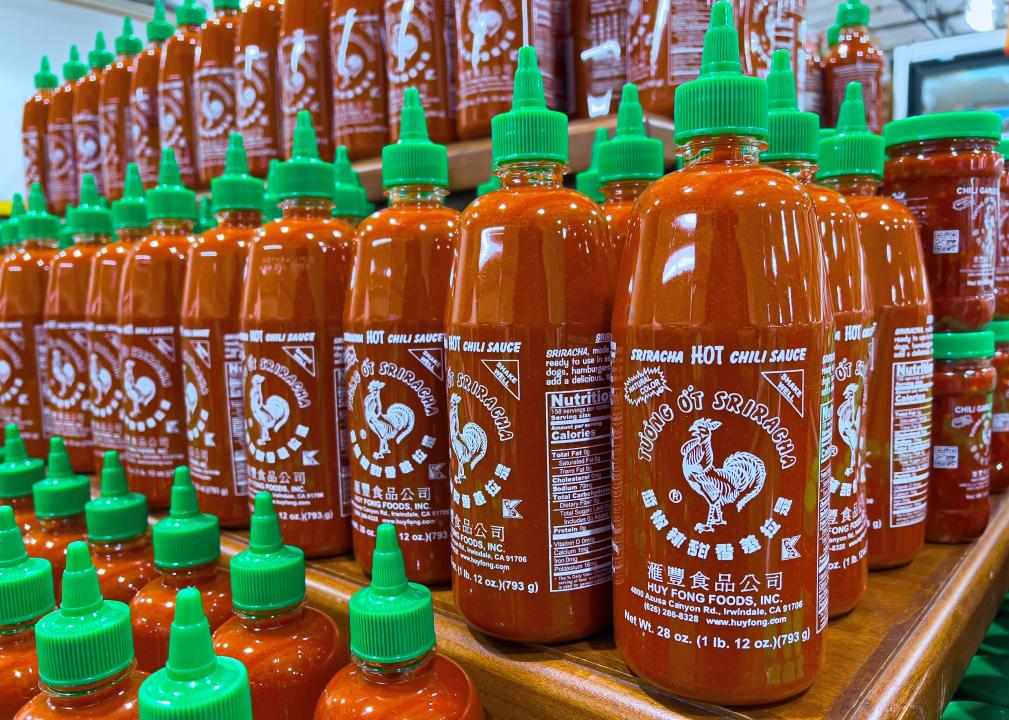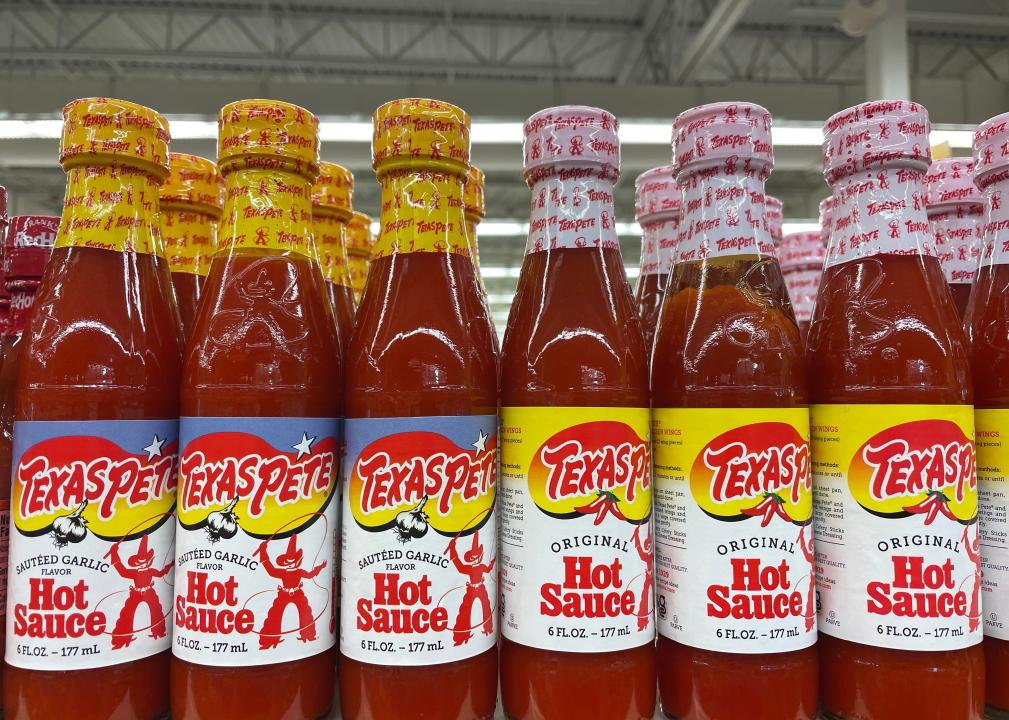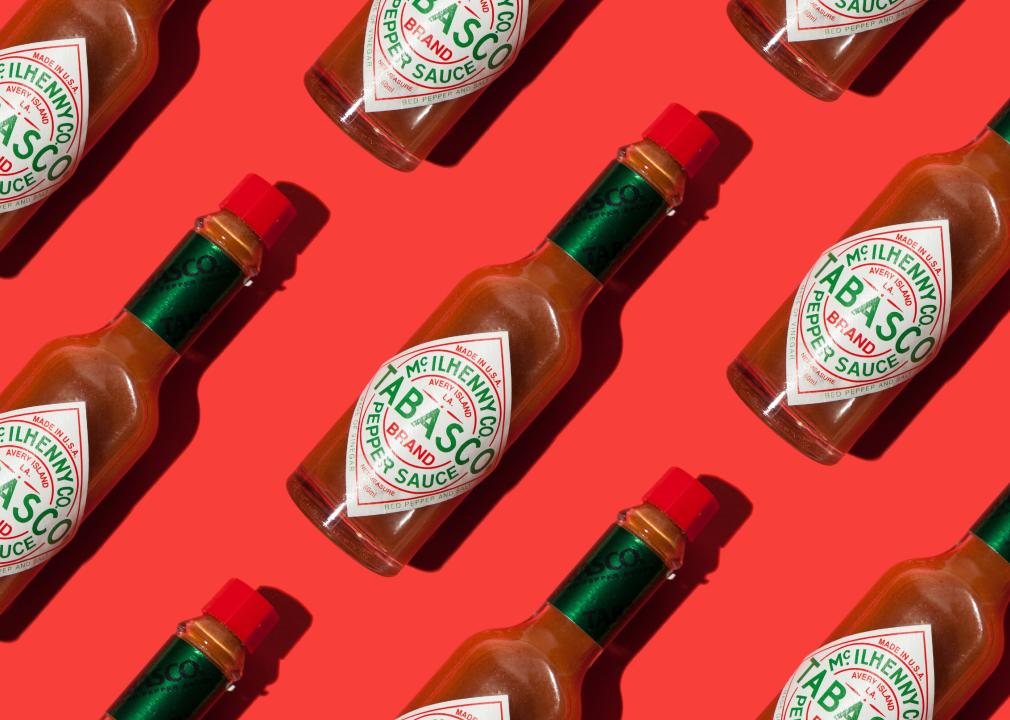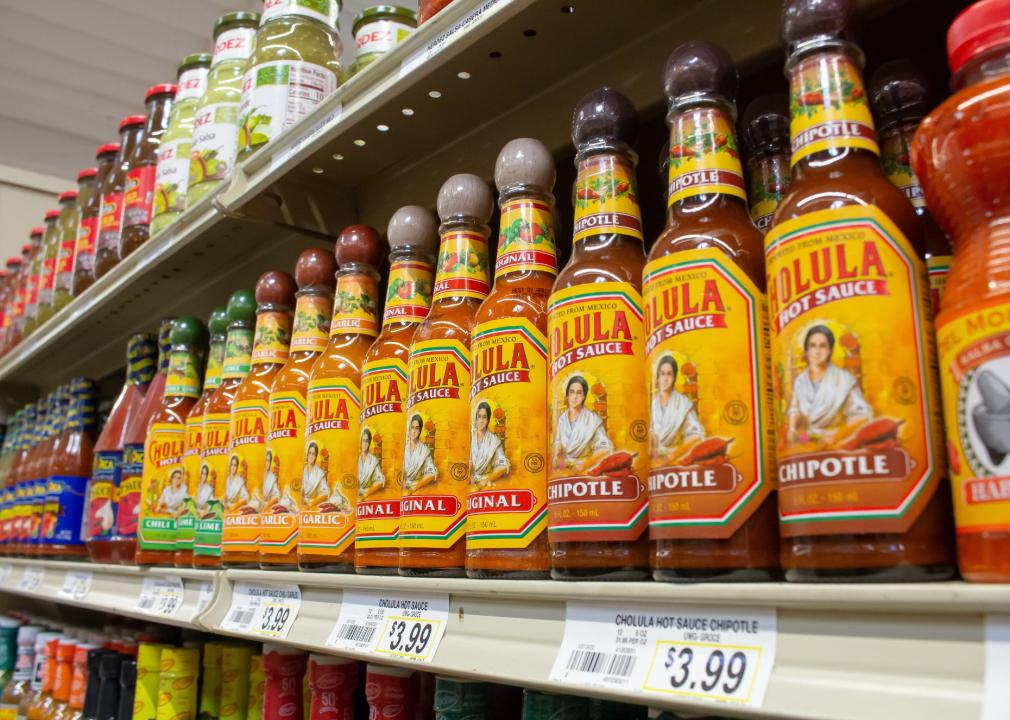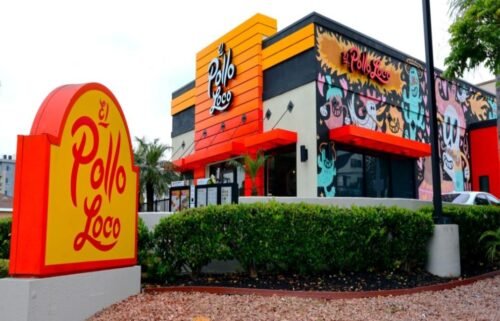The most popular hot sauces in the US—and the history behind them
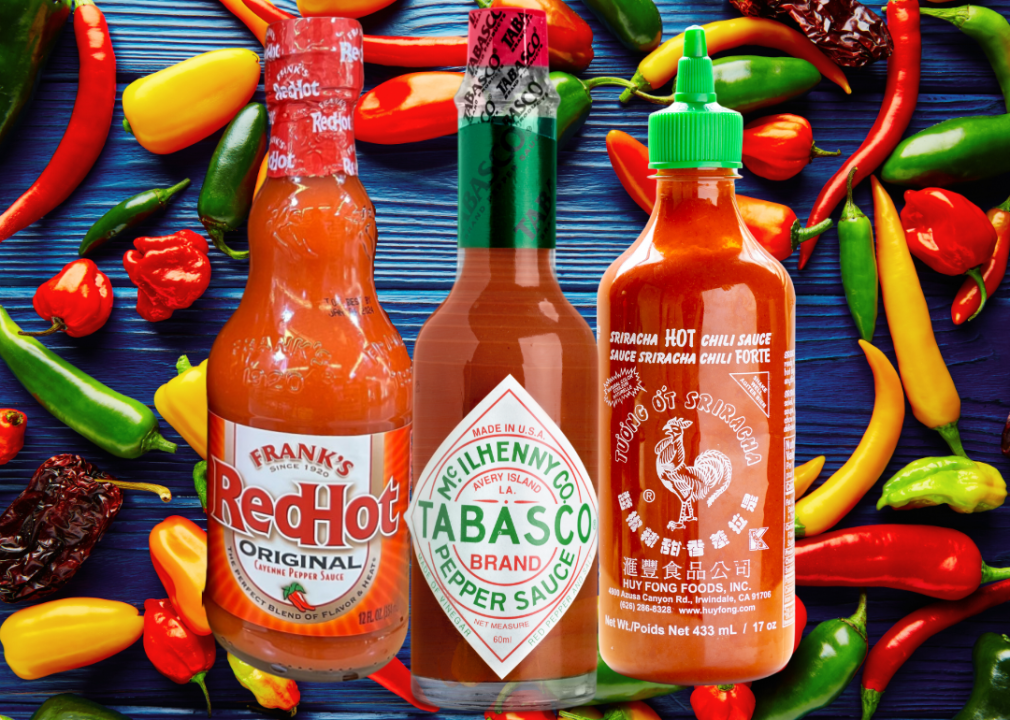
Photo Illustration by Stacker // Shutterstock // Canva
The most popular hot sauces in the US—and the history behind them
Three hot sauce bottles against a background of hot peppers.
Since the turn of the century, the hot sauce craze has taken off in the U.S. The stateside hot sauce market skyrocketed 150% between 2000 and 2014, a more significant growth spurt than four other condiments combined (barbecue sauce, ketchup, mayonnaise, and mustard), according to Euromonitor data. By 2023, the industry was valued at $2.6 billion, and it’s only expected to go up from there, IBISWorld estimates.
Part of the reason for the boom, which peaked around 2017, is that many Americans have adopted a liking for spicier foods thanks to changes in immigrant populations, leading more restaurants and grocery stores to cater to these flavors. Hot sauce now goes far beyond the single grocery store option on the shelf or the ubiquitous Tabasco table offering of yesteryear. It’s evolved from a niche condiment to a global culinary phenomenon to meet the expanding consumer tastes.
Small-batch producers have even entered the scene, providing unique flavor profiles for consumers seeking distinctive tastes and premium ingredients—shifting hot sauce from a mere topping to a gourmet experience. Since its inception in 2015, the YouTube talk show “Hot Ones” has garnered millions of fans dedicated to the love of the sauce.
To see which hot sauces are on the tip of Americans’ tongues, Stacker looked at Instacart data on the 10 most popular hot sauces in the U.S. according to shoppers, then cross-referenced those findings with YouGov data on both the most beloved and most recognized products in the U.S. to determine the most popular hot sauces stateside.
The hot sauces are ranked by popularity, with ties broken by fame ratings. On YouGov, “popularity” is defined by the percentage of respondents who had a favorable opinion of the product, while “fame” is defined as the percentage of respondents who merely know of a product. There are also some honorable mentions included that were in the Instacart report but didn’t register on YouGov’s list.
Read on to see if your favorite mouth-tingling hot sauce made the list, and who knows? You might find your next favorite.
![]()
calimedia // Shutterstock
#4. Huy Fong Sriracha
Plastic bottles of Huy Fong Food Sriracha sauce in a supermarket aisle.
– Popularity: 41%
– Fame: 63%
– Scoville scale: 2,200 SHUs
Huy Fong Foods’ sriracha, named after the coastal town of Si Racha in Thailand, where the chili sauce originated, was created by Huy Fong Foods founder David Tran. The name Huy Fong honors the freighter Tran boarded in Vietnam to come to the U.S. as a refugee in 1979. A year later, he started selling the hot sauce out of his Chevy van in Los Angeles.
Initially catering to the growing Asian immigrant community, sriracha soared in popularity due to its versatility and distinctive flavor—characterized by a balanced blend of spice, tang, and garlic—owing its heat to sun-ripened red jalapeño peppers. The iconic rooster logo and green-capped bottle gained a cult following and subsequently mainstream appeal. Huy Fong Sriracha is so popular that when a chili pepper shortage halted production in 2022, panic ensued.
Today, the sauce is in numerous cuisines, deliciously enhancing everything from noodles to soup to pizza, as the bottle suggests. Now, 45 years after he first came to the U.S., Tran’s net worth is at $1 billion, according to Forbes as of January 2024.
Billy F Blume Jr // Shutterstock
#3. Texas Pete Original Hot Sauce
Grocery store with Texas Pete hot sauce on shelf.
– Popularity: 41%
– Fame: 72%
– Scoville scale: 747 SHUs
Texas Pete hot sauce has its roots in Winston-Salem, North Carolina, where it was first introduced in 1929 by Sam Garner and his three sons—Thad, Ralph, and Harold—who’d previously bought a barbecue restaurant where they made a famous barbecue sauce. The hot sauce was their second success in the condiment world (and their Eastern Carolina BBQ Sauce is still going strong).
Initially known as “Mexican Joe,” the hot sauce underwent a name change in the 1930s to Texas Pete, an homage to the piquant cuisine of Texas and a nickname Harold went by. Its combination of tangy vinegar, aged peppers, and a balanced heat level has made it a staple in the Southeast and beyond. The sauce compliments various dishes, including traditional Southern fare, barbecue, fried chicken, and Tex-Mex cuisine. Today, Texas Pete is still run by third- and fourth-generation Garner family members—and they’ve even gotten into the sriracha game.
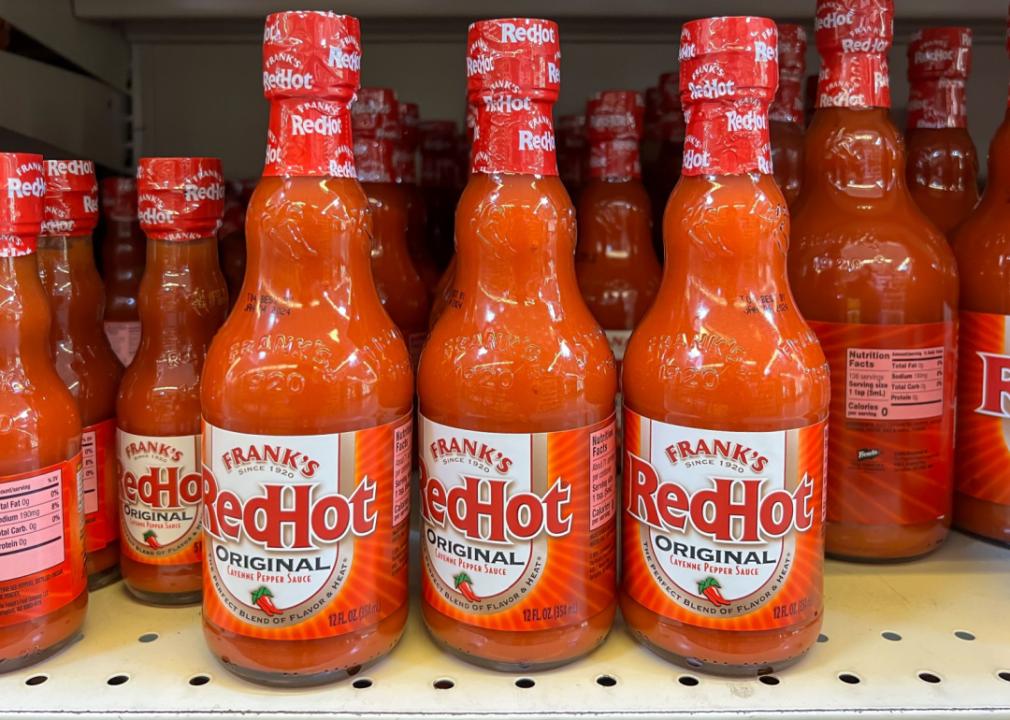
JHVEPhoto // Shutterstock
#2. Frank’s RedHot Original Cayenne Pepper Hot Sauce
Several bottles of Frank’s RedHot hot sauce at a local grocery store.
– Popularity: 48%
– Fame: 80%
– Scoville scale: 450 SHUs
Frank’s RedHot sauce has a spicy and rich history dating back to the turn of the 20th century. In 1896, traveling salesman Jacob Frank wanted a career change and decided to go into business with his two brothers in Cincinnati, establishing the Frank Tea and Spice Co.
As the Cincinnati Enquirer reports, the trio first sold spices in small, shelf-sized packages; then they expanded to peanut butter in 1906; and finally, they ventured into hot sauce territory in 1918. That’s when Frank traveled to New Iberia, Louisiana, where, with the help of pepper farmer Adam Estilette, they created a recipe for a hot sauce made with cayenne peppers rather than tabasco peppers.
The sauce, first bottled and sold in 1920, blends spicy and tangy flavors thanks to its unique cayenne pepper base. But what makes Frank’s RedHot sauce extra special is that the peppers are pickled with salts, garlic, and vinegar before they’re aged in oak casks.
Though it long had its fans, the popularity of Frank’s surged in the 1960s after being featured in the original Buffalo wing recipe at the Anchor Bar in Buffalo, New York. By 1980, the company was producing 72,000 Frank’s RedHot sauce a day.
In 2017, McCormick acquired the parent company of Frank’s RedHot for $4.2 billion. Today, the second most popular hot sauce in the U.S. is sold in 20 countries worldwide.
IKagadiy // Shutterstock
#1. Tabasco Original Red Sauce
Spicy tabasco sauce on red background pattern.
– Popularity: 63%
– Fame: 95%
– Scoville scale: 2,500 SHUs
The most popular hot sauce in America, Tabasco also has a history dating back to the 19th century, when food lover and avid gardener Edmund McIlhenny first created it on Avery Island in Louisiana. Its popularity grew thanks to its unique blend of aged red peppers, salt, and vinegar that impart a bold, tangy flavor.
As the story goes, according to the official Tabasco website, McIlhenny was given seeds of Capsicum frutescens peppers that had either come from Mexico or Central America in the mid-1800s. He grew his first commercial pepper crop in 1868, and by the following year, he’d sent out more than 650 bottles of his brand-new hot pepper sauce, offering it wholesale for $1 apiece to grocers in New Orleans and around the Gulf Coast at large. He called it Tabasco, believed to be from the native Aztec word tlapaco, meaning “humid land.”
By the late 1870s, the hot sauce’s recognition had grown, and it was sold throughout the U.S. and Europe, becoming a staple condiment cherished for enhancing various foods.
Today, Tabasco comes in nine different varieties, and the company is still family-owned and operated on Avery Island. For the ultimate hot sauce enthusiasts, there’s even a museum where you can learn about how Tabasco is made.
The Image Party // Shutterstock
Honorable mentions
Several bottles of Cholula hot sauce on display at a local grocery store.
There are quite a few famous hot sauces that didn’t make the cut, based on YouGov data, but still deserve a mention, starting with a trio from Mexico.
First up is Cholula Hot Sauce, which comes from a 100-year-old family recipe. It boasts a combination of arbol and piquín peppers, providing a flavorful heat complemented by a hint of garlic. Then there’s Tapatío, created in 1971 and characterized by its well-balanced spice level and citrusy undertones. And finally, there’s Salsa Valentina, introduced in 1960 by Don Manuel Maciel Mendez. This one stands out for its use of Mexican puya peppers.
If Louisiana flavors are more your speed, there’s The Original Louisiana Brand Hot Sauce, a Southern classic that dates back to 1928 and delivers a cayenne-induced kick. It’s still made in New Iberia, Louisiana, just like Frank’s RedHot. There’s also Crystal Hot Sauce, another Louisana favorite, started in 1923 by Alvin Baumer. It features a milder heat with a hint of sweetness that complements everything from oysters and chicken to dips and cocktails. Little did Baumer know the recipe for “Crystal Pure” he discovered in a drawer would be the spicy gift that keeps on giving.
Also popular, according to Instacart’s findings, is Burman’s Hot Sauce, an Aldi dupe for Frank’s RedHot, which fans say is remarkably similar in taste and at a fraction of the price.
Story editing by Jaimie Etkin. Copy editing by Paris Close. Photo selection by Clarese Moller.
